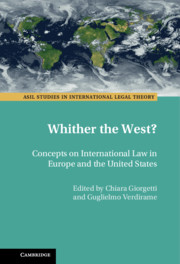Book contents
- Whither the West?
- ASIL Studies in International Legal Theory
- Whither the West?
- Copyright page
- Contents
- About the Authors
- Acknowledgements
- Introduction
- I The Idea of International Law in the Divided West
- II Specific Areas in International Law: Whither the West?
- 1 International Law and Constitutional Law: Is There a Final Arbiter?
- 5 Authority and Dialogue
- 6 Treaty Conditions and Constitutions
- 2 International Adjudication and the Development of International Law
- 3 International Law and the Use of Force
6 - Treaty Conditions and Constitutions
Walls, Windows, or Doors?
from 1 - International Law and Constitutional Law: Is There a Final Arbiter?
Published online by Cambridge University Press: 29 April 2021
- Whither the West?
- ASIL Studies in International Legal Theory
- Whither the West?
- Copyright page
- Contents
- About the Authors
- Acknowledgements
- Introduction
- I The Idea of International Law in the Divided West
- II Specific Areas in International Law: Whither the West?
- 1 International Law and Constitutional Law: Is There a Final Arbiter?
- 5 Authority and Dialogue
- 6 Treaty Conditions and Constitutions
- 2 International Adjudication and the Development of International Law
- 3 International Law and the Use of Force
Summary
Swaine examines the relationship between domestic constitutions and treaties. He notes that states frequently seek to interpose reservations, understanding, declarations or other “treaty conditions” that seek to change the international legal effect of a treaty for the state. The chapter considers three ways in which conditions based on constitutional claims can describe the relationship between the domestic and international domains: by establishing walls, windows or doors, paying particular attention to the “reservations dialogue” described by the International Law Commission in its Seventeenth Report on Reservation to Treaties. That dialogue reveals different dispositions toward such conditions, including as between the United States, which has employed them heavily, and European states, which have been the most innovative in assessing them. While that dialogue continues to evidence the walls, or barriers, that persist between constitutions and treaties, it remains possible to renovate.
Keywords
- Type
- Chapter
- Information
- Whither the West?International Law in Europe and the United States, pp. 146 - 172Publisher: Cambridge University PressPrint publication year: 2021

